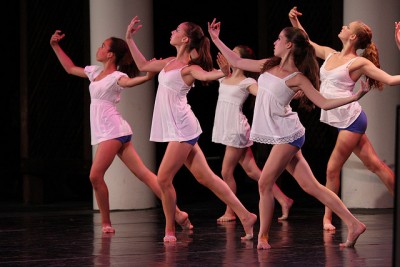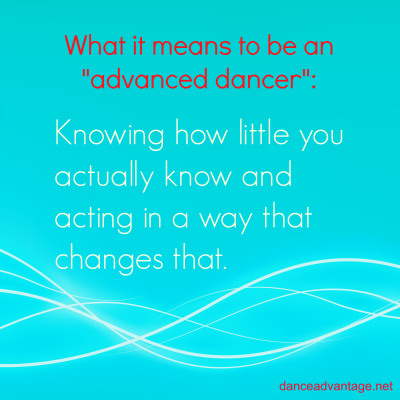“How do you challenge the advanced dancer?”
I was asked this last year in my interview when I went from my position in a K-8 school, where I worked with urban kids, to working with high school students in a suburban district. It’s a question that keeps floating around in my mind.
I think my answer was, “It depends on how you define advanced.” I went on to explain how I think a student would answer that question and how I would address their needs through that definition.
Now that the school year is rolling along, though, I grapple with how to reconcile how students define “advanced” and how I do.
The students I am currently working with range, across the program, from those that have never studied dance and thought it’d be fun, to those with some studio training, to the hyper-trained competition dancer clocking 30 hours a week at a private studio. I even have a kid taking dance because he lost a bet. (Boy, am I glad he did- he’s a character that adds so much to the energy of the group).

What is challenging the advanced dancers?
In the advanced level, a “company” consisting of dancers in grades 9-12 who auditioned for placement, the difference naturally feels most obvious. Yes, there is a gap between the philosophy of their studio experiences that the philosophy I offer, mainly rooted within concert dance but for the most part we’ve been navigating that quite well. I think it is the stress that is holding us back the most.
The students I see now have incredible pressure to perform at the top of their game, in every game. They are expected by their parents, their teachers, their counselors, and themselves to have high test scores, high G.P.A., and high achievement in whatever “activity” they participate.
In the dance class, I see them putting a lot of energy into the movement they already do well and the movement they like. If challenged beyond those comfort zones, the effort shifts as well as the engagement.
- Their body language tells me they will tolerate the class but are really just waiting for it to be over.
- Their writing tells me they feel vulnerable and fear judgement.
- Their bodies tell me they need corrections and when I give them, their faces tell me they are afraid of being told they’ve made a mistake.
I know the kids well enough now to know they aren’t lazy and they aren’t searching only for compliments. They are under a lot of pressure.
So, how DO I challenge advanced dancers?
I explain that…
Also, I dim the lights. I use a soft voice. I explain why we do what we do.
I invite them to focus on who they are and not always on how they perform.
I hope they start to think beyond themselves. I structure group experiences that feature physical thinking, collaboration, and humor.
 I request they make some mistakes intentionally so they develop skills on how to handle mistakes made unintentionally. I point out my own mistakes. I put them in scenarios they can’t plan for.
I request they make some mistakes intentionally so they develop skills on how to handle mistakes made unintentionally. I point out my own mistakes. I put them in scenarios they can’t plan for.
I push them to think and speak and write and make, then think and speak and write about what they made.
I show them a lot of videos and interviews that expose them to real artists working in dance, speaking about taking risks. I give them permission.
I ask them what they learned instead of how they did.
I try to make them laugh instead of cry. I ask them to share what they are reading.
I remind them that life is happening right now, not when they get their scores or their college acceptance, and it is happening as we are together. We may as well enjoy our time together and make something with it. Rigorously.
As it turns out, it isn’t so different from what I do with my beginning dancers, though the “advanced” dancers tend to feel more uncomfortable.
There are days they’d rather I “just clean” the choreography. As a teacher, that discomfort makes me feel the lessons are urgent and the learning is critical.
For my at-risk kids, the work felt urgent because I wanted to give them an “out”. For these kids, it feels urgent because I want them to have a way back “in”. To be and not just do.
Heather Vaughan-Southard MFA, is a choreographer, dance educator, and performer based in Michigan. She currently directs the dance program at the Everett High School Visual and Performing Arts Magnet in Lansing. With the philosophy of teaching dance as a liberal art, Ms. Vaughan-Southard collaborates with numerous arts and education organizations throughout the state. She has danced professionally in Chicago, Detroit, Los Angeles, and New York and has performed works by Mia Michaels, Lar Lubovitch, Donald McKayle, Billy Siegenfeld, Alexandra Beller, Debra Levasseur-Lottman, and Bob Fosse. As a choreographer, her work has been credited by the Los Angeles Times for “creating heat.” She has recently choreographed for the dance programs at Michigan State University, Grand Valley State University, Lansing Community College and is the former dance professor at Albion College. She is a regular guest artist and blogger for Dance in the Annex, an innovative dance community in Grand Rapids. Heather received her MFA in Dance from the University of Michigan, BFA in Dance from Western Michigan University and K-12 certification in Dance from Wayne State University. Read Heather’s posts.

